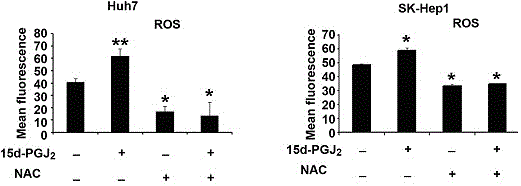Inhibitor for hepatoma carcinoma cell and application to aspect of inhibiting tumor growth thereof
A technology of liver cancer cells and inhibitors, which is applied in the directions of anti-tumor drugs, medical preparations containing active ingredients, and pharmaceutical formulas, can solve problems such as unclearness and achieve the effect of inhibiting growth
- Summary
- Abstract
- Description
- Claims
- Application Information
AI Technical Summary
Problems solved by technology
Method used
Image
Examples
Embodiment 1
[0049] Negative feedback regulation between NOX2-induced ROS formation and AKT activation in PPARγ agonist-treated liver cancer cells
[0050] (1) The effect of PPARγ agonists on reactive oxygen species in liver cancer cells detected by flow cytometry, only Huh7 and SK-Hep1 cells are used as examples, but the application to other liver cancer cell lines is not limited
[0051] Huh7 and SK-Hep1 cells were incubated at 37°C, 5% CO 2 and saturated humidity conditions, the cell maintenance medium is DMEM high-glucose medium, including 10% fetal bovine serum, 100 μg / ml streptomycin and 100U / ml penicillin. After the cells adhered to the wall, they were all replaced with DMEM high-glucose culture medium containing 1% fetal bovine serum, and the following reagents were added to the culture medium: 15d-PGJ 2 or free radical scavengers NAC or DMSO.
[0052] in,
[0053] Treatment group 1 alone: adding 15d-PGJ 2 (0.5 μg / ml);
[0054] Single treatment group 2: adding free radic...
Embodiment 2
[0095] PPARγ agonists and AKT inhibitors synergistically inhibit the growth and stemness phenotype of hepatocellular carcinoma cells
[0096] (1), PPARγ agonist 15d-PGJ 2 The effect of the combination with the AKT inhibitor tricilibine on the apoptosis of liver cancer cells, only Huh7 cells are used as an example, but it is not limited to the application of other liver cancer cell lines
[0097] Huh7 cells were incubated at 37°C, 5% CO 2 and saturated humidity conditions, the cell maintenance medium is DMEM high-glucose medium, containing 10% fetal bovine serum, 100 μg / ml streptomycin and 100U / ml penicillin. After the cells adhere to the wall, change to DMEM high-glucose culture medium containing 1% fetal bovine serum, and add the following reagents to the culture medium: 15d-PGJ 2 , tricilibine or DMSO.
[0098] in,
[0099] Treatment group 1 alone: adding 15d-PGJ 2 (0.5 μg / ml);
[0100] Single treatment group 2: adding tricitribine (10μM);
[0101] Single tr...
Embodiment 3
[0145] PPARγ agonists and AKT inhibitors synergistically suppress tumor growth
[0146] (1) The effect of PPARγ agonist rosiglitazone and AKT inhibitor triciribine synergistically on tumor growth, only Huh7 cells are used as an example, but the application is not limited to other liver cancer cell lines
[0147] The Huh7 cells stably expressing green fluorescent protein (GFP) were normally cultured in vitro, and the Huh7 cells in the logarithmic growth phase were digested with trypsin, washed twice with PBS, and then the concentration of Huh7 cells was adjusted to 2×10 with PBS. 7 cells / ml, each nude mouse was subcutaneously injected with 100 μl, and the administration began 4 days after subcutaneous tumor bearing, the specific administration method was as follows Figure 3A As shown, they were divided into 4 groups: control group, rosiglitazone treatment group (100mg / kg / day, intragastric administration), triciribine treatment group (1mg / kg / day, intraperitoneal administrat...
PUM
 Login to View More
Login to View More Abstract
Description
Claims
Application Information
 Login to View More
Login to View More - R&D
- Intellectual Property
- Life Sciences
- Materials
- Tech Scout
- Unparalleled Data Quality
- Higher Quality Content
- 60% Fewer Hallucinations
Browse by: Latest US Patents, China's latest patents, Technical Efficacy Thesaurus, Application Domain, Technology Topic, Popular Technical Reports.
© 2025 PatSnap. All rights reserved.Legal|Privacy policy|Modern Slavery Act Transparency Statement|Sitemap|About US| Contact US: help@patsnap.com



